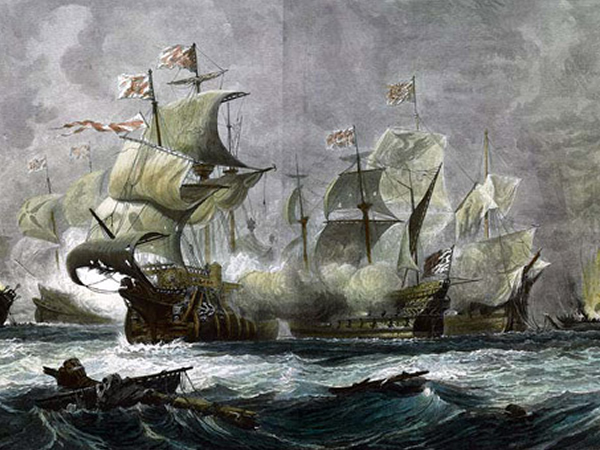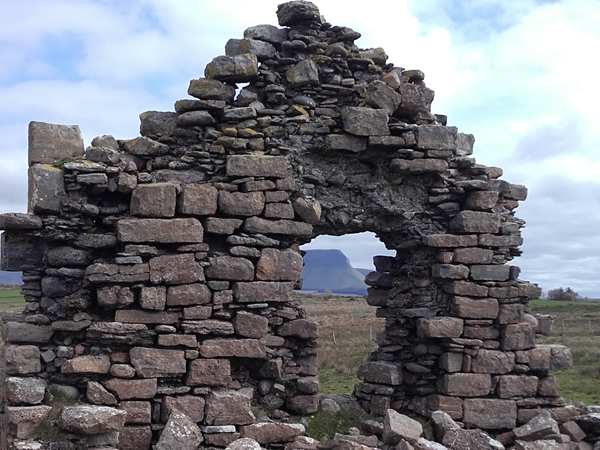Captain Francisco De Cuellar
Captain Francisco De Cuellar’s incredible escape story is unparalleled in Ireland or Europe for its fascinating detail on how the Spanish were received in the northwest of Ireland during the 16th Century. The quotations within the text below are extracted from a document outlining De Cuellar’s escape, written by Hugh Allingham and Robert Crawford in 1897.
When you join Auriel Robinson on her fascinating Spanish Armada Trail, she will tell you the story of how one man escaped the perils of the sea and a hoard of soldiers who were plundering the beach at Streedagh in 1588 after his ship and two others became shipwrecked in a horrendous storm which we would call nowadays, a cyclone ‘On the fifth day, there sprang up so great a storm on our beam, with a sea up to the heavens’.

Photo Credit: britishbattles.com
Captain De Cuellar was on board ‘La Lavia’ when his ship wrecked, and he witnessed the whole event and survived to tell the tale. The reason why we know what happened in detail is because he wrote a long letter to King Phillip the II of Spain when he finally reached safe territory at Antwerp, 13 months after he was washed ashore at Streedagh Beach in Co. Sligo. ‘Many men were drowning within the ships; others, casting themselves into the water, sank to the bottom without returning to the surface’. He continues… ‘captains threw their gold chains and crown-pieces into the sea’ and ‘the land and shore were full of enemies who went about jumping with delight at our misfortune’.

After witnessing the loss of his comrades, he hides in the rushes and has a badly injured leg but survives the night and continues to seek refuge at a church nearby ‘When I arrived, I found it deserted and the church and images of the saints burned and completely ruined, and twelve Spaniards hanging within the church’. As he escaped later through a wood with two others, he encounters English soldiers ‘when they saw me passing through the trees, they changed their course towards me, and the Englishman came up saying, ‘Yield, Spanish poltroon, and made a slash at me with a knife, desiring to kill me’. His valuables were taken from him including valuable Spanish relics and golf coins and a French lady who was with the soldiers took pity on him and brought him to safety. Here, he remarks that she, from her hut, sent him a boy with a poultice made of herbs to put onto his wound and butter and milk and gave him a small piece of oaten bread to eat.

He was told of a local King, known to the King of Spain himself, who lived close by and was sent there for help. He remarks that it was through mountains that appeared ‘about six leagues off’. A league in those days equals to c. 3 miles which would mean that he had to walk with an injured leg for 9 miles! He may, however, have been talking about nautical miles which makes it slightly less distance, still it must have been difficult! He was then given a horse and remarks that he was shot at with a cross-bow at one point and the boy who helped him said, ‘Save yourself, Spain, many Sassana horsemen are coming this way’, ‘Sassana’ meaning the English soldiers.

When he and several other survivors reached the castle of O’Rourke or known to De Cuellar as ‘Senor de Reurque’, he saw that O ‘Rourke had fled to defend his own lands. This castle is known as Castletown and still stands today in a field in ruins. He says that this man was a good Christian and an enemy of the heretics, always carrying on war with them. O’ Rourke had to flee also to save his neck from being severed as he dared to help the Spanish survivors (sadly hung, drawn and quartered in London in 1591 for high treason). De Cuellar goes on to explain what he had to endure, who he met and lost long the way, how he fought for another Irish chieftain in the region and then how he fled to the north of Ireland in the hopes of receiving more help to get him to safe territory. The letter is a remarkable document and worth a read when you get home or during your stay in Ireland. You will get a good feel for the landscape that De Cuellar traversed and the wilderness of this north western coastline if you join Auriel on her Spanish Armada Trail.

Photo Credit: geograph.ie
